Figures & data
Figure 1. (a) Time chart of experimental procedures and observations. (b) Consecutive weaning of foals in group C and alignment of weaning days for data evaluation. Abbreviations: RR, heart beat interval; exam, examination; C, progressive removal of two mares each day as shown.
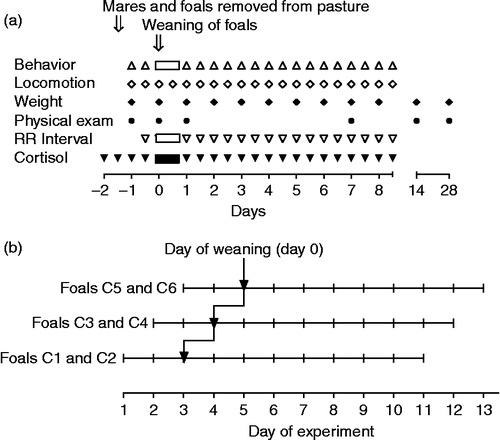
Table I. Significant differences (p-values; F-values; degrees of freedom, df) for salivary cortisol concentrations, cardiac RR interval, and HRV variables, SDRR, and RMSSD, on different experimental days.
Figure 2. Respiratory rate in foals subjected to different weaning protocols (group A: simultaneous weaning without unrelated adult mares, n = 6; group B: simultaneous weaning in the presence of two adult mares unrelated to the foals, n = 5; group C: consecutive weaning without unrelated adult mares) from 1 day before to 4 weeks after weaning, n = 6. Arrow indicates time of weaning (GLM for repeated measures: differences between times p < 0.001; interactions time × group p < 0.01). Data are mean ± SEM.
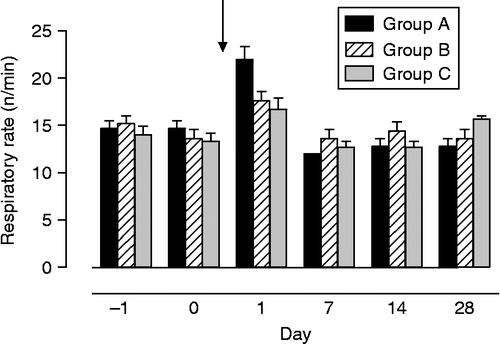
Figure 3. Body weight development of foals subjected to different weaning protocols (group A: simultaneous weaning without unrelated adult mares, n = 6; group B: simultaneous weaning in the presence of two adult mares unrelated to the foals, n = 5; group C: consecutive weaning without unrelated adult mares) from 1 day before to 8 weeks after weaning, n = 6. Arrow indicates time of weaning (GLM for repeated measures: differences between times p < 0.001, differences between groups p < 0.05; interactions time × group p < 0.001). Data are mean ± SEM.
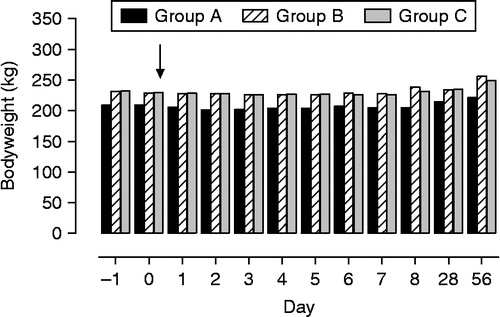
Figure 4. (a) Vocalization, (b) defecation, and (c) feeding behavior in foals subjected to different weaning protocols (group A: simultaneous weaning without unrelated adult mares, n = 6; group B: simultaneous weaning in the presence of two adult mares unrelated to the foals, n = 5; group C: consecutive weaning without unrelated adult mares) from 1 day before to 8 days after weaning, n = 6. Arrow indicates time of weaning; GLM for repeated measures: vocalization, differences between times p < 0.001, differences between groups p < 0.001, interactions time × group p < 0.001; defecation, differences over time p < 0.001; interactions time × group p < 0.001; feeding score: Friedman test, differences between times p < 0.001; Kruskal Wallis H-test, *significant differences between groups p < 0.05. Data are mean ± SEM.
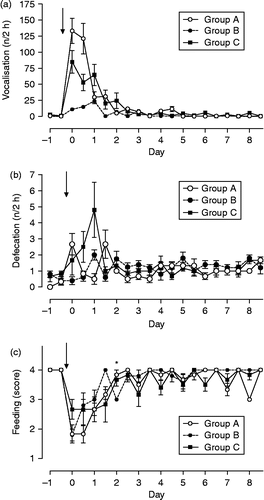
Figure 5. (a) Locomotion activity, (b) standing, and (c) lying time determined by pedometers in foals subjected to different weaning protocols (group A: simultaneous weaning without unrelated adult mares, n = 6; group B: simultaneous weaning in the presence of two adult mares unrelated to the foals, n = 5; group C: consecutive weaning without unrelated adult mares) from 1 day before to 8 days after weaning, n = 6. Arrow indicates time of weaning (GLM for repeated measures: locomotion, differences between times p < 0.001, interactions time × group p < 0.001, standing, differences between times p < 0.001, differences between groups p < 0.001, interactions time × group p < 0.001; lying, differences between times differences between groups p < 0.01, interactions time × group p < 0.001). Data are mean ± SEM.
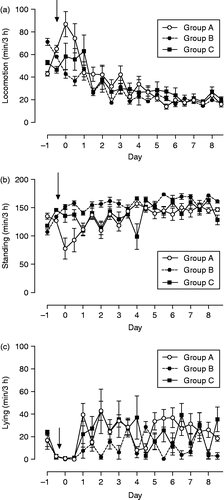
Figure 6. Salivary cortisol concentration in foals subjected to different weaning protocols (group A: simultaneous weaning without unrelated adult mares, n = 6; group B: simultaneous weaning in the presence of two adult mares unrelated to the foals, n = 5; group C: consecutive weaning without unrelated adult mares) from 1 day before to 8 days after weaning, n = 6. Arrow indicates time of weaning (GLM for repeated measures: +, significant differences between times; × , significant differences between groups; #, interactions time × group for respective day, for details see ). Note changes in scale on x-axis. Data are mean ± SEM.
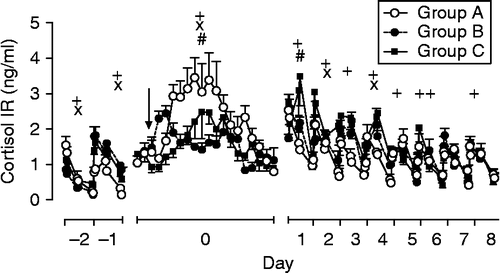
Figure 7. (a) Cardiac RR interval, (b) SDRR, and (c) RMSSD in foals subjected to different weaning protocols (group A: simultaneous weaning without unrelated adult mares, n = 6; group B: simultaneous weaning in the presence of two adult mares unrelated to the foals, n = 5; group C: consecutive weaning without unrelated adult mares) from 1 day before to 8 days after weaning, n = 6. Arrow indicates time of weaning. (GLM for repeated measures, +, significant differences between times; × , significant differences between groups; #, interactions time × group for respective day, for details see ). Data are mean ± SEM.

